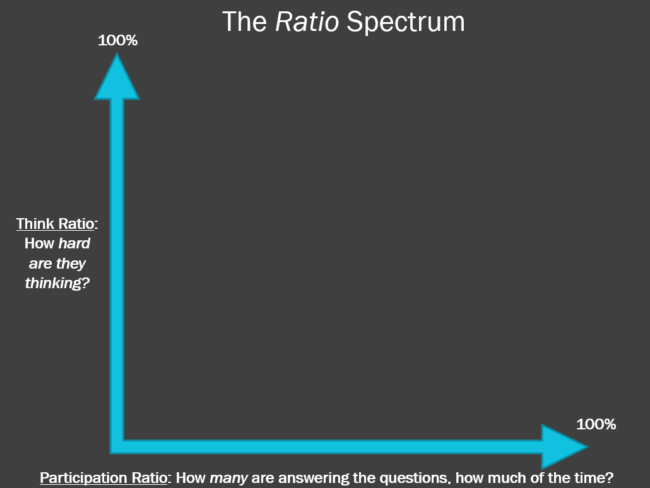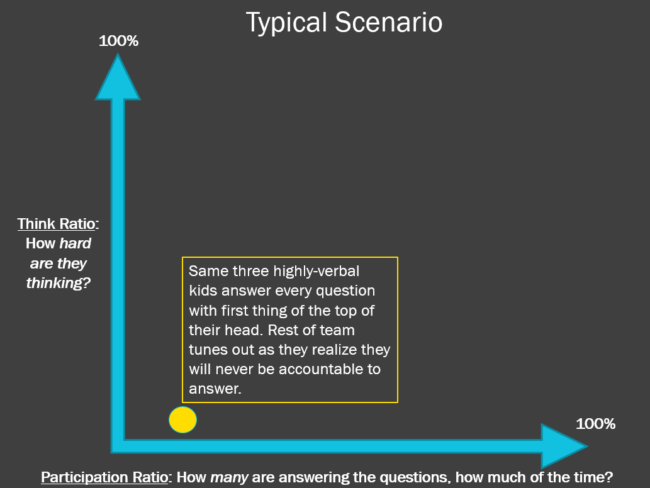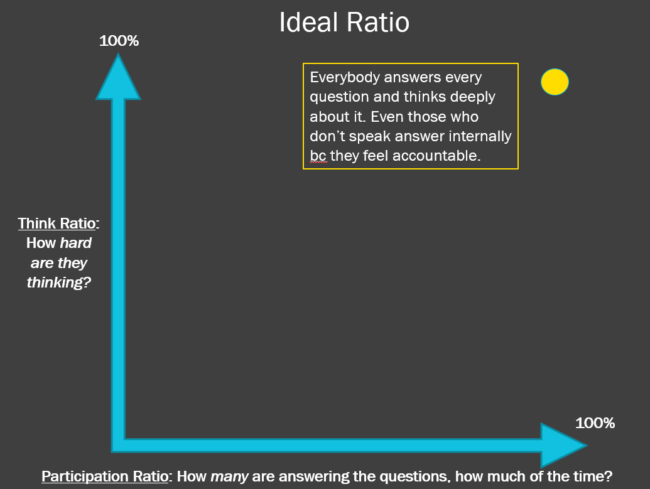01.04.19Building Mental Engagement Among Athletes Through Questioning
Coaches love to ask questions to help their athletes understand the decisions they must make during performance.
This is especially true in group invasion games like soccer (football), rugby, basketball and hockey–games that require an especially high degree of coordination and shared decision-making.
One potential problem with asking questions of athletes is making sure that the environment in which they are answered has a high ‘Ratio’.
Here’s what I mean by that. This image represents way of thinking about thinking on the field or in classrooms. We call it the Ratio Spectrum. On the X axis it asks: How many people are answering a given question when it’s asked? On the Y axis it asks: how deeply are they thinking about their answers? If everyone answers every question you’re on the right. If everyone thinks fully and deeply you’re near the top.

If you assessed a typical training session you might get a result like this:

The coach asks a question but it’s the same few athletes who call out answers. Maybe it’s 2 or 3 of them. Perhaps they’re very verbal. Maybe they are trying to please the coach. But their answers always come quickly. Over time it becomes a race and they say the first thing they can think of. Other players realize they won’t have to (or be able to) speak so they stop answering in their heads.
Even if the coach’s questions are outstanding the results will be poor if the Ratio is this low.
So what does it take to get to a more preferable scenario, one like this one where everyone answers every question thoughtfully?

Well first I have to stop my players from calling out answers. I have to slow them down so they really think. Then I have to make everyone feel accountable. The best way to do this is to Cold Call with some frequency so players know they might be asked to answer. And ideally I would even use some tools like Turn and Talk to get everyone more comfortable with and in the habit of sharing answers.
To do that a coach would need to set expectations with my athletes about what the rules of participation are. Recently I posted a video of James Beeston doing just that as he coaches a team of boys from Black Watch Premier.
I wanted to follow up today to show a few minutes of James’ questioning from later in the same session. I hope you’ll agree that his Ratio is strong. Here’s the video and a few notes on what he does:
Beeston.TurnandTalk.ColdCalltoCFU from TLAC Blog on Vimeo.
James is working with the boys on using up-back-through to break defensive lines. The video is shot between two activities on that topic and he wants to make sure they’re as mentally engaged as they are physically.
Notice first of all how intentional James is about where and how the boys are standing. All in a semi-circle, facing him so he can see their eyes. No soccer balls.
- His first question, is “How can we use this is the game?” He kicks it off with a Turn and Talk. Great move here because everyone will have answered the question, not just the kids who are called on. And everyone gets comfortable talking about the game. But as he also makes clear (“i’m gonna be looking for answers”), the boys will need to do their best work in their pairs because he’s going to Cold Call them coming out of it.
- His question out of the Turn and Talk is, as advertised, a Cold Call: “Matteo, what’d you find.” After Matteo’s answer James notices Quinn’s got his hand subtly raised. He’d thought of something different (probably the best answer… about using the move to drag a defender out and exploit space behind).
- But even after that answer James Cold Calls again, this time asking Garrett what he thought.
- Next he’s on to another line of questioning: technique-wise what do we need to do to execute. He Cold Calls Caden who talks about the different weighting of the passes and then James asks Keegan, “What else?” This is a great question because listening is as important to thinking as talking is and in asking Keegan to build off of Caden’s answer he’s socializing players to listen carefully to another.
If we want athletes to work as hard mentally as they do physically, there’s a lot of work to do to build positive, engaged, accountable cultures with a high Ratio and James does a great job of showing some of the ways coaches might do that.

Always enjoys these coaching insights with video examples. This is another gem. Thank you.
Minor typo: “To do that a *couch* would need…”
Thanks, Chris. I am the king of the typo. Though i also don’t want to underestimate the role of couches in education. 🙂